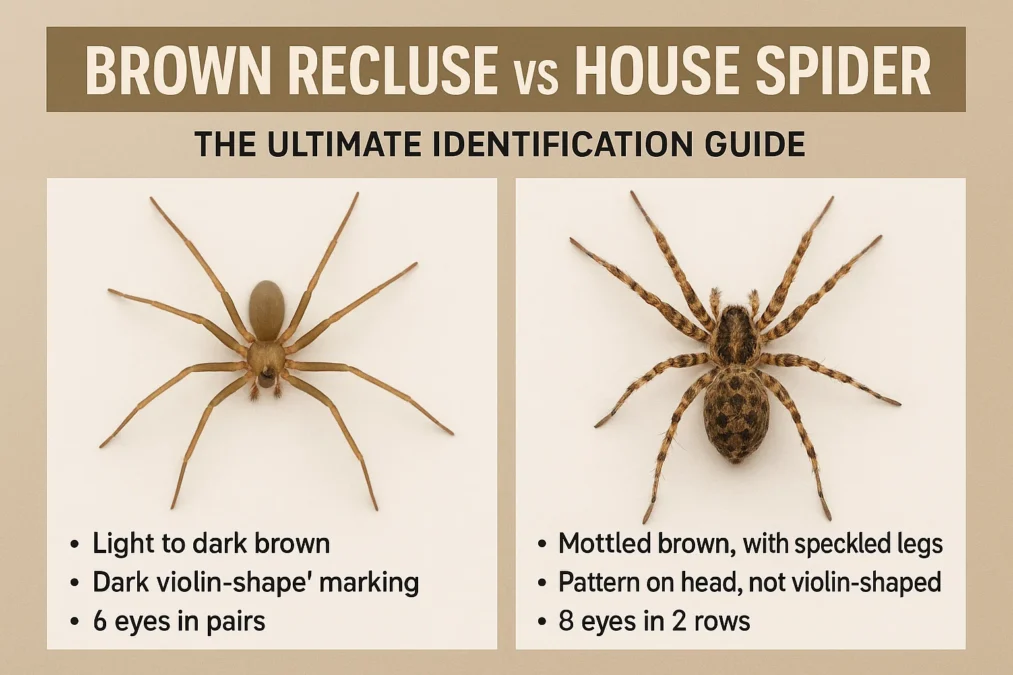You’ve just spotted a leggy, eight-legged roommate scurrying across your basement floor or tucked in a corner of the garage. A jolt of adrenaline hits. In the back of your mind, a fearful question emerges: “Could that be a brown recluse?” This single thought is enough to send many homeowners into a panic, and for good reason. The brown recluse spider is one of the most feared arachnids in North America, its name synonymous with nasty, necrotic bites. But what if the spider you’re looking at is just a common, and utterly harmless, house spider? Misidentification is incredibly common, leading to unnecessary worry and, sometimes, misguided attempts at control.
The ability to tell a brown recluse vs house spider apart is a crucial piece of knowledge for anyone living in certain regions. It’s the difference between knowing when to call an exterminator or a doctor and when to simply gently escort a beneficial pest-controller outside (or leave it be). This comprehensive guide will arm you with all the information you need. We’ll dive deep into the distinct markings, behaviors, habitats, and geographic ranges of these two spiders. We’ll demystify the facts and fiction surrounding their bites, and by the end, you’ll be able to confidently identify which spider you’re dealing with, putting your mind at ease.
Understanding the Stakes: Why Proper Identification Matters
The core of the fear surrounding spiders like the brown recluse stems from their venom. Brown recluse spiders possess a cytotoxic venom, which means it can damage and destroy cells and tissues surrounding the bite area. In a small percentage of cases, this can lead to a condition known as loxoscelism, where the skin and sometimes even deeper tissues break down, creating a slow-healing wound that may require medical attention. The very real, though often exaggerated, potential for a severe reaction makes knowing your enemy—or rather, knowing that your “enemy” is actually a friend—paramount.
On the flip side, common house spiders are virtually harmless to humans. Their venom is not medically significant to people or pets. A bite might cause a minor, temporary itch or a small red bump similar to a mosquito bite, but that’s typically the extent of it. Mistaking a harmless house spider for a brown recluse can lead to needless panic, the unnecessary use of pesticides, and the death of an animal that was actually doing you a favor by eating true pests like flies, mosquitoes, and other insects. Proper identification promotes both safety and a more rational, eco-friendly approach to sharing our living spaces with the local arachnid population.
Meet the Contenders: A Profile of the Brown Recluse
To win the game of identification, you first need to know the players. Let’s start with the spider that causes the most concern: the brown recluse. Scientifically known as Loxosceles reclusa, this spider is a creature of legend and fear. It’s not particularly large, flashy, or aggressive, but its potential bite has earned it a formidable reputation. Understanding its true nature, beyond the hype, is the first step.
Brown recluses are typically between ¼ to ½ an inch in body length, with their legs extending to about the size of a quarter. They are, as their name implies, uniformly colored in shades of tan, dark brown, or even a yellowish-gray. They are not hairy or striped like many other spiders; their body and legs are covered in a fine, velvety hair giving them a smooth appearance. They are fiddle players in the orchestra of the arachnid world, but their instrument is located on their back.
The Telltale Fiddle: The Brown Recluse’s Marking
The single most famous identifier of a brown recluse spider is the dark, violin-shaped marking on its cephalothorax (the fused head and thorax region to which the legs attach). This is why they are sometimes called “fiddle-back” or “violin” spiders. It’s crucial to know how to correctly identify this mark. The “neck” of the violin points backward toward the spider’s abdomen. The entire violin shape is often dark and distinct, but in younger spiders or those that have recently molted, it can be faint. It’s important to note that while this violin is a key identifier, other spiders can have similar-looking, but not identical, markings, so it should never be the sole feature you rely on.
The Eyes Have It: A Unique Arrangement
If you can get close enough to look a brown recluse in the face—which is not recommended!—you would see one of its most unique and definitive features: its eye pattern. Most spiders have eight eyes arranged in two rows of four. The brown recluse, however, is different. It has only six eyes, arranged in three pairs called dyads. There is one pair on the center-left, one pair on the center-right, and one pair directly in front. This trio of pairs is a dead giveaway and is a more reliable identifier than the violin mark alone, though it requires very close inspection.
Meet the Contenders: A Profile of the Common House Spider
The term “house spider” is a bit of a catch-all, but it most commonly refers to spiders in the genus Parasteatoda (like the American house spider) and Tegenaria (like the giant house spider). For the purpose of comparison with the brown recluse, we’ll focus on the more ubiquitous American house spider (Parasteatoda tepidariorum). This is the spider you’re most likely to find building messy, tangled cobwebs in your window frames, basement corners, and attic eaves.
American house spiders are generally small to medium-sized, with females growing larger than males. Their body length is similar to a brown recluse’s, but their overall appearance is often messier. Their coloration is not uniform; they are typically a mottled brown or grey with darker patterns or stripes on their legs and abdomen. Their most noticeable feature is their web—an irregular, tangled, three-dimensional “cobweb” designed to trap wandering insects. They are not sleek like the recluse; they often appear a bit more robust and textured.
Web Weavers and Homebodies
Unlike the nomadic brown recluse, the common house spider is a dedicated web-builder. It spends almost its entire life in or very near its web, waiting for prey to become ensnared. When it does, the spider rushes out, quickly wraps the insect in silk, and delivers a paralyzing bite. You will rarely find a American house spider wandering far from its web unless it’s a mature male searching for a mate. This sedentary nature is a key behavioral difference from the hunting-style brown recluse.
Hobo Spider vs Tegenaria Agrestis: Untangling a Web of Misidentification and Myth
A Harmless Housemate
The common house spider is precisely that: common. It has evolved to live in close association with humans, thriving in the sheltered environments we create. Its venom is effective on small insects but is utterly harmless to humans. A bite is extremely rare and would only occur if the spider was directly pressed against skin, such as by putting on a glove it had crawled into. Even then, the effects are minimal and short-lived. These spiders are beneficial allies, providing free, chemical-free pest control by capturing and eating insects that we truly find pesky.
Side-by-Side: A Detailed Comparison Table
This table breaks down the key differences between a brown recluse and a common house spider at a glance.
| Feature | Brown Recluse Spider (Loxosceles reclusa) | Common House Spider (Parasteatoda tepidariorum) |
|---|---|---|
| Primary Marking | Dark, distinct violin shape on cephalothorax (facing backward). | Mottled, chevron-like, or spotted patterns on abdomen; no violin. |
| Coloration | Uniform tan, brown, or dark yellow. Legs are smooth and same color. | Mottled brown, grey, or tan with darker, often striped, legs. |
| Body & Legs | Smooth, velvety appearance with slender, uniform legs. No spines. | Slightly more robust, textured body. Legs may have darker banding. |
| Eye Arrangement | 6 eyes arranged in 3 pairs (dyads). | 8 eyes, typically arranged in two rows. |
| Web Type | Irregular, off-white, sticky “sheet” webs for retreat, not for hunting. | Messy, tangled, three-dimensional “cobwebs” for catching prey. |
| Behavior | Reclusive, nomadic hunter. Wanders at night in search of prey. | Sedentary web-dweller. Rarely leaves its web except to mate. |
| Typical Habitat | Cluttered, undisturbed areas: attics, basements, boxes, woodpiles, behind furniture. | Active corners of living spaces: windows, ceiling corners, eaves, garages. |
| Geographic Range | Central & Southern U.S. (e.g., Missouri, Kansas, Oklahoma, Tennessee, Arkansas). | Found throughout the entire United States and most of the world. |
| Venom | Cytotoxic; medically significant, can cause necrotic wounds in some cases. | Mild; not medically significant. May cause minor, temporary irritation. |
| Aggression | Not aggressive; bites only in defense (e.g., pressed against skin). | Not aggressive; bites are exceedingly rare and only in defense. |
Geographic Distribution: Where You Will and Won’t Find Them
One of the most critical factors in the brown recluse vs house spider debate is location. The common house spider lives, as its name suggests, in houses everywhere across the globe. If you live in North America, you almost certainly have common house spiders in your home, and that is perfectly normal. Their range is vast and uninterrupted.
The brown recluse, however, has a very specific and limited native range. Its home is primarily the south-central United States. The core of its territory includes states like Missouri, Kansas, Oklahoma, Arkansas, Tennessee, and parts of Texas, Louisiana, Mississippi, Alabama, Georgia, and even southern Ohio, Indiana, and Illinois. If you do not live in one of these states, the chances of you finding a native brown recluse population in or around your home are extremely low. Isolated cases can occur when spiders hitchhike in boxes or furniture moved from these areas, but established populations outside this range are rare. Always consider your location before assuming a spider is a recluse.
Behavioral Differences: Reclusive Nomad vs. Sedentary Weaver
The names of these spiders offer a huge clue to their behavior. The brown recluse is, above all, reclusive. It is a nomadic hunter that does not use a web to catch prey. Instead, it ventures out at night to hunt insects and other spiders. During the day, it seeks shelter in dark, quiet, and undisturbed places. It prefers to hide in cardboard boxes, piles of stored clothing, old newspapers, woodpiles, basements, and the voids behind walls or under furniture. It is not a spider you are likely to see marching across your living room floor in broad daylight.
The common house spider exhibits the opposite behavior. It is a dedicated web-builder and spends its entire life in or near its messy, tangled web. It is sedentary, waiting for its next meal to fly or wander into its trap. You will find it in active areas of the home—in the corner of a window where flies gather, in the ceiling corner of a room, or in the garage near a light source. It is adapted to live in the busier parts of our habitat, while the brown recluse shuns them. Seeing a spider in its web is an almost sure sign it is not a brown recluse.
The Web Tell: A Story of Two Architectures
Examining the web is one of the easiest ways to distinguish between these two arachnids. The common house spider is a master of the cobweb. Its web is a non-symmetrical, messy, tangled array of silk threads designed to be an effective trap for unsuspecting insects. It’s haphazard, sticky, and three-dimensional. The spider will usually be seen hanging upside down in the web, waiting.
In stark contrast, the brown recluse builds a web that is not for catching prey. Its web is an irregular, off-white, sheet-like structure that serves primarily as a daytime retreat and a place for the spider to lay its eggs. It is not sticky and is not designed to ensnare food. You might find it in a secluded spot like a storage box or behind a bookshelf. If you see a spider actively living in a classic, messy “spider web,” you are almost certainly looking at a house spider, not a recluse.
Bite Symptoms: Knowing What to Look For
This is the most important section for personal health and safety. The reaction to a bite from these two spiders could not be more different. First and foremost, it is vital to know that both spiders are reluctant to bite. Bites are almost always a result of accidental pressure, like rolling onto one in bed or putting on a piece of clothing the spider has hidden in.
A bite from a common house spider is typically inconsequential. At worst, it might result in a small, red, itchy bump that disappears within a day or two, similar to many other minor insect bites. It does not cause ulcerating wounds or systemic illness. Many people may not even realize they have been bitten.
A suspected brown recluse bite, however, is a different matter. It’s important to note that the majority of brown recluse bites result in only minor, localized reactions and heal without serious intervention. However, in some cases, the bite can become more severe. The initial bite is often painless or may feel like a mild sting. Within several hours, the site may become red, swollen, and tender. The classic, but not always present, severe reaction involves the development of a blister followed by a necrotic lesion where the tissue breaks down, forming a deep, ulcerating wound that can take weeks or months to heal. Systemic symptoms like fever, chills, and body aches can sometimes accompany a significant bite. If you suspect you have been bitten by a brown recluse, it is crucial to seek medical attention, especially if you develop a growing wound or systemic symptoms.
Expert Quote: “The fear of brown recluse spiders far outweighs their actual threat. The vast majority of alleged recluse bites are actually skin infections or bites from other insects. True diagnosis requires verification of the spider by an expert, which rarely happens. Knowing the spider’s limited range and true identifying features is the best first step in risk assessment.” — Dr. Arachnologist, Ph.D. in Entomology.
Prevention and Control: Keeping Unwanted Guests Out
Whether you’re concerned about recluses or just want to minimize all spiders, prevention strategies are similar and promote a generally cleaner home. The goal is to eliminate hiding spots and entry points. Start by sealing cracks and gaps around windows, doors, and foundation lines with caulk. Install tight-fitting screens on windows and doors. Reduce clutter in storage areas like basements, attics, and garages. Avoid storing boxes and clothing on the floor; use plastic, sealed containers instead. Keep beds pulled away from walls and avoid letting bedding drag on the floor. Regularly vacuum and dust in corners, under furniture, and behind appliances to remove spiders, webs, and egg sacs.
For brown recluse-specific concerns in endemic areas, these steps are even more critical. Be extremely cautious when moving stored items. Wear gloves when handling firewood, cardboard boxes, or stored materials. Shake out shoes, gloves, and clothing that have been sitting in storage before putting them on. If you suspect a significant infestation, contact a professional pest control expert who has experience with brown recluse spiders. They can properly identify the problem and use targeted, effective control methods. For common house spiders, simple removal of webs and the spiders themselves is usually all that’s needed, though many people choose to coexist with these helpful predators.
Debunking Common Myths and Misconceptions
The world of spiders is riddled with misinformation, and the brown recluse vs house spider confusion is ground zero for many myths. One of the biggest myths is that brown recluses are aggressive. They are not. They have no interest in biting humans and will only do so as an absolute last resort when they feel threatened and trapped. Another common myth is that they are common everywhere. As discussed, their range is limited, and many reported sightings outside this range are cases of mistaken identity.
Perhaps the most pervasive myth is that every nasty skin lesion is a “spider bite.” The reality is that the vast majority of skin infections diagnosed as spider bites, even within the brown recluse’s range, are actually caused by bacteria like MRSA. These bacterial infections can cause symptoms eerily similar to the necrotic wounds of a recluse bite. Without actually collecting and identifying the spider that caused the bite, a definitive diagnosis is often impossible. This has led to a massive over-reporting of brown recluse bites and an inflated sense of their prevalence and danger.
Conclusion
The journey to understanding the difference between a brown recluse vs house spider is a journey from fear to knowledge. The common house spider, with its messy webs in the corners of our rooms, is a benign and beneficial insectivore that poses no threat. The brown recluse, while possessing a medically significant venom, is a reclusive creature with a limited range and an overwhelming reluctance to bite. The key to peaceful coexistence lies in accurate identification—paying attention to the telltale violin marking, understanding geographic ranges, observing behavior and web types, and debunking common myths.
Armed with this information, you can assess the eight-legged occupants of your home with a calm and expert eye. You can save yourself from unnecessary panic when you see a common house spider and respond with appropriate caution if you truly live in an area and find a spider that matches the brown recluse’s description. Knowledge is the best pesticide and the best antidote to fear, allowing you to share your space intelligently and safely with the fascinating world of arachnids.
Frequently Asked Questions (FAQs)
How can I be absolutely sure if a spider is a brown recluse?
Absolute certainty requires examining the spider, preferably by an expert. The most reliable identifier is the unique arrangement of six eyes in three pairs. The violin mark is a strong indicator, but other spiders can have similar markings. Combining the violin mark with geographic location, uniform color, and reclusive behavior will give you a very confident identification. If in doubt, you can trap the spider in a jar and take it to your local university extension office or pest control professional for ID.
I found a spider that looks like a brown recluse, but I don’t live in its range. What should I do?
The first thing to do is remember that geography is a powerful clue. It is highly unlikely to be a native brown recluse. It is most likely a look-alike spider, such as a male southern house spider, a pirate spider, or a cellar spider. Try to identify it using the specific markers in this guide (especially the eye pattern if you can safely see it). You can also use online resources from reputable universities or contact a local entomologist. Avoid killing it unnecessarily, as it is likely a harmless species.
What should I do immediately if I think I’ve been bitten by a brown recluse?
Stay calm. First, wash the bite area thoroughly with soap and water to reduce the risk of infection. Apply a cool compress to reduce swelling and pain. Elevate the affected limb if possible. Seek medical attention, especially if you develop a worsening wound, a blister, or systemic symptoms like fever or muscle aches. If you can safely capture the spider (without risking another bite), bring it with you in a sealed container for identification. Do not apply tourniquets, attempt to suck out the venom, or apply ice directly to the skin.
Are common house spiders beneficial to have around?
Absolutely. Common house spiders are incredibly beneficial housemates. They are a form of natural, chemical-free pest control. Their diet consists primarily of nuisance insects such as house flies, mosquitoes, ants, and moths. By capturing and eating these insects, they help keep their populations in check. Unless their webs are in a location that is aesthetically bothersome, leaving them be is a great way to manage other pests in your home.
If I have brown recluses in my home, should I try to handle it myself?
While you can reduce populations through rigorous cleaning, decluttering, and sealing entry points, dealing with a confirmed brown recluse infestation is often best left to professionals. DIY sprays are often ineffective because the spiders hide in deep, inaccessible voids. Pest control experts have the experience and tools to correctly identify the problem, locate harborages, and use targeted pesticides and methods that are more effective and safer for your household than over-the-counter solutions.



